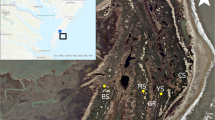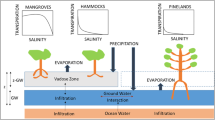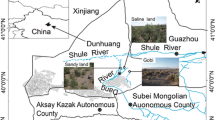Abstract
Mediterranean-type climate (MTC) regions around the world are notable for cool, wet winters and hot, dry summers. A dominant vegetation type in all five MTC regions is evergreen, sclerophyllous shrubland, called chaparral in California. The extreme summer dry season in California is moderated by a persistent low-elevation layer of marine fog and cloud cover along the margin of the Pacific coast. We tested whether late dry season water potentials (Ψmin) of chaparral shrubs, such as Arctostaphylos species in central California, are influenced by this coast-to-interior climate gradient. Lowland coastal (maritime) shrubs were found to have significantly less negative Ψmin than upland interior shrubs (interior), and stable isotope (δ13C) values exhibited greater water use efficiency in the interior. Post-fire resprouter shrubs (resprouters) had significantly less negative Ψmin than co-occurring obligate seeder shrubs (seeders) in interior and transitional chaparral, possibly because resprouters have deeper root systems with better access to subsurface water than shallow-rooted seeders. Unexpectedly, maritime resprouters and seeders did not differ significantly in their Ψmin, possibly reflecting more favorable water availability for shrubs influenced by the summer marine layer. Microclimate and soil data also suggest that maritime habitats have more favorable water availability than the interior. While maritime seeders constitute the majority of local Arctostaphylos endemics, they exhibited significantly greater vulnerability to xylem cavitation than interior seeders. Because rare seeders in maritime chaparral are more vulnerable to xylem cavitation than interior seeders, the potential breakdown of the summer marine layer along the coast is of potential conservation concern.






Similar content being viewed by others
References
Ackerly DD (2004) Functional strategies of chaparral shrubs in relation to seasonal water deficit and disturbance. Ecol Monogr 75:25–44
Alder NN, Pockman WT, Sperry JS, Nuismer S (1997) Use of centrifugal force in the study of xylem cavitation. J Exp Bot 48:665–674
Anacker B, Rajakaruna N, Ackerly D, Harrison S, Keeley J, Vasey M (2011) Ecological strategies in California chaparral: interacting effects of soils, climate, and fire on specific leaf area. Plant Ecol Divers 4:179–188
Anderson RL, Byrne R, Dawson TE (2008) Stable isotope evidence for a foggy climate on Santa Cruz Island California at ~16,600 cal yr BP. Palaeogeogr Palaeoclimatol 262:176–181
Baldwin BG, Goldman DH, Keil DJ, Patterson R, Rosatti TJ, Wilken DH (2012) The Jepson manual: vascular plants of California, 2nd edn. University of California Press, Berkeley
Bhaskar R, Ackerly DD (2006) Ecological relevance of minimum seasonal water potentials. Physiol Plant 127:353–359
Bhaskar R, Valiente-Banuet A, Ackerly DD (2007) Evolution of hydraulic traits in closely related species pairs from mediterranean and non-mediterranean environments of North America. New Phytol 176:718–726
Bolker BM, Brooks ME, Clark CJ, Geange SW, Poulsen JR, Henry M, Stevens H, White JS (2009) Generalized linear mixed models: a practical guide for ecology and evolution. Trends Ecol Evol 24:127–135
Boorse GC, Ewers FW, Davis SD (1998) Response of chaparral shrubs to below freezing temperatures: acclimation, ecotypes, seedlings vs. adults. Am J Bot 85:1224–1230
Boykin LM, Vasey MC, Parker VT, Patterson R (2005) Two lineages of Arctostaphylos (Ericaceae) identified using the internal transcribed spacer (ITS) of the nuclear genome. Madroño 52:139–147
Burgess SSO, Dawson TE (2004) The contribution of fog to the water relations of Sequoia sempervirens (D Don): foliar uptake and prevention of dehydration. Plant Cell Environ 27:1027–1034
Cody ML (1986) Diversity, rarity, and conservation in Mediterranean-climate regions. In: Soulé ME (ed) Conservation biology: the science of scarcity and diversity. Sinauer Associates, Sunderland, pp 122–152
Cooper WS (1922) The broad-sclerophyll vegetation of California: an ecological study of the chaparral and its related communities, vol 319. Carnegie Institute, Washington, DC, pp 1–124
Cowling RM, Rundel PW, Lamont BB, Arroyo MK, Arianoutsou M (1996) Plant diversity in Mediterranean-climate regions. Trends Ecol Evol 11:362–366
Cowling RM, Ojeda F, Lamont BB, Rundel PW, Lechmere-Oertel R (2005) Rainfall reliability a neglected factor in explaining convergence and divergence of plant traits in fire-prone Mediterranean-climate ecosystems. Global Ecol Biogeogr 14:509–519
Davis C (1981) Comparative ecology of six members of the Arctostaphylos andersonii complex. PhD thesis. University of California Davis, Davis
Davis SD, Ewers FW, Wood J, Reeves JJ, Kolb KJ (1999) Differential susceptibility to xylem cavitation among three pairs of Ceanothus species in the Transverse Mountain Ranges of southern California. Ecoscience 6:180–186
Davis SD, Ewers FW, Sperry JS, Portwood KA, Crocker M, Adams GC (2002) Shoot dieback during prolonged drought in Ceanothus (Rhamnaceae) chaparral of California: a possible case of hydraulic failure. Am J Bot 89:820–882
Dawson TE (1998) Fog in the California redwood forest: ecosystem inputs and use by plants. Oecologia 117:476–485
Dawson TE, Mambelli S, Plamboeck AH, Templar PH, Tu KP (2002) Stable isotopes in plant ecology. Annu Rev Ecol Syst 33:507–559
Eppling C, Lewis H (1942) The centers of distribution of the chaparral and coastal sage associations. Am Midl Nat 27:445–462
Farquhar GD, Ehleringer JR, Hubick KT (1989) Carbon isotope discrimination and photosynthesis. Annu Rev Plant Physiol Plant Mol Biol 40:503–537
Fischer DT, Still CJ, Williams AP (2009) Significance of summer fog and overcast for drought stress and ecological functioning of coastal California endemic plant species. J Biogeogr 36:783–799
Griffin JR (1978) Maritime chaparral and endemic shrubs of the Monterey Bay region California. Madroño 25:65–112
Hacke UG, Sperry JS, Pittermann J (2000) Drought experience and cavitation resistance in six shrubs from the Great Basin, Utah. Basic Appl Ecol 1:31–41
Harrison S, Safford HD, Grace JB, Viers JH, Davies KF (2006) Regional and local species richness in an insular environment: serpentine plants in California. Ecol Monogr 76:41–56
Hellmers H, Horton JS, Juhren O’Keefe GJ (1955) Root systems of some chaparral plants in southern California. Ecology 36:667–678
Jacobs DK, Haney TA, Louie KD (2004) Genes, diversity and geologic process on the Pacific coast. Annu Rev Earth Planet Sci 32:601–652
Jacobsen AL, Ewers FW, Pratt RB, Paddock WA III, Davis SD (2005) Do xylem fibers affect vessel cavitation resistance? Plant Physiol 139:546–556
Jacobsen A, Pratt RB, Ewers FW, Davis SD (2007) Cavitation resistance among 26 chaparral species of southern California. Ecol Monogr 77:99–115
Johnstone JA, Dawson TE (2010) Climatic context and ecological implications of summer fog decline in the coast redwood region. Proc Natl Acad Sci USA 107:533–4538
Kahmen A, Sachse D, Arndt SK, Tu KP, Farrington H, Vitousek PM, Dawson TE (2011) Cellulose δ 18 O is an index of leaf-to-air vapor pressure difference (VPD) in tropical plants. Proc Natl Acad Sci USA 108:1981–1986
Keeley JE (1992) A Californian’s view of fynbos. In: Cowling RM (ed) The ecology of fynbos: nutrients fire and diversity. Oxford University Press, Capetown, pp 372–388
Keeley JE (2000) Chaparral. In: Barbour MG, Billings WD (eds) North American terrestrial vegetation, 2nd edn. Cambridge University Press, Cambridge, pp 203–253
Keeley JE, Davis F (2007) Chaparral. In: Barbour MG, Keeler-Wolf T, Schoenherr A (eds) Terrestrial vegetation of California, 3rd edn. University of California Press, Berkeley, pp 339–366
Keeley JE, Zedler PH (1978) Reproduction of chaparral shrubs after fire: a comparison of sprouting and seeding strategies. Am Midl Nat 99:142–161
Keeley JE, Bond WJ, Bradstock RA, Pausas G, Rundel PW (2012) Fire in Mediterranean ecosystems: ecology, evolution, and management. Cambridge University Press, Cambridge
Kelly VR, Parker VT (1990) Seed bank survival in sprouting and nonsprouting Arctostaphylos species. Am Midl Nat 124:114–123
Kummerow J, Krause D, Jow W (1977) Root systems of chaparral shrubs. Oecologia 29:163–177
Limm EB, Simonin KA, Bothman AG, Dawson TE (2009) Foliar water uptake: a common water acquisition strategy for plants of the redwood forest. Oecologia 161:449–459
Maherali H, Pockman WT, Jackson RB (2004) Adaptive variation in the vulnerability of woody plants to xylem cavitation. Ecology 85:2184–2199
Meentemeyer RK, Moody A, Franklin J (2001) Landscape-scale patterns of shrub-species abundance in California chaparral. Plant Ecol 156:19–41
Millar CI (2012) Geologic, climatic, and vegetation history of California. In: Baldwin BG, Goldman DH, Keil DJ, Patterson R, Rosatti TJ, Wilken DH (eds) The Jepson manual: vascular plants of California (2nd edn). University of California Press, Berkeley, pp 49–68
Miller PC, Poole DK, Miller PM (1983) The influence of annual precipitation, topography, and vegetative cover on soil moisture and summer drought in southern California. Oecologia 56:385–391
Myers N, Mittermeier RA, Mittermeier CG, da Fonseca GAB, Kent J (2000) Biodiversity hotspots for conservation priorities. Nature 403:853–858
Odion D, Tyler C (2002) Are long fire-free periods needed to maintain the endangered, fire-recruiting shrub Arctostaphylos morroensis (Ericaceae)? Conserv Ecol 6:4. Available at: http://www.consecol.org/vol6/iss2/art4
Ojeda F, Brun G, Vergara JJ (2005) Fire, rain, and the selection of seeder and resprouter life-histories in fire-recruiting woody plants. New Phytol 168:155–165
Parker VT, Vasey MC (2004) Arctostaphylos gabilanensis, a newly described auriculate-leaved manzanita from the Gabilan Mountains, California. Madroño 51:322–325
Parker VT, Vasey MC, Keeley JE (2012) Arctostaphylos. In: Baldwin BG, Goldman DH, Keil DJ, Patterson R, Rosatti TJ, Wilken DH (eds) The Jepson manual: vascular plants of California, 2nd edn. University of California Press, Berkeley, pp 686–702
Paula S, Pausas JG (2011) Root traits explain different foraging strategies between resprouting life histories. Oecologia 165:321–331
Pockman WT, Sperry JS (2000) Vulnerability to xylem cavitation and the distribution of Sonoran desert vegetation. Am J Bot 87:1287–1299
Pratt RB, North GB, Jacobsen AL, Ewers FW, Davis SD (2010) Xylem root and shoot hydraulics is linked to life history type in chaparral seedlings. Funct Ecol 24:70–81
Raven PH, Axelrod DI (1978) Origin and relationships of the California flora. Univ Calif Publ Bot 72:1–134
Sawyer JO, Keeler-Wolf T, Evens JM (2009) A manual of California vegetation, 2nd edn. California Native Plant Society, Sacramento
Schimper AFW (1903) Plant Geography upon a physiological basis. Clarendon, Oxford
Snyder MA, Sloan LC, Diffenbaugh NS, Bell JS (2003) Future climate change and upwelling in the California Current. Geophys Res Lett 30:1823. doi:10.1029/2003GL017647
Sperry JS, Hacke UG (2002) Desert shrub water relations with respect to soil characteristics and plant functional type. Funct Ecol 16:367–378
Sperry JS, Donnelly JR, Tyree MT (1988) A method for measuring hydraulic conductivity and embolism in xylem. Plant Cell Environ 11:35–40
Stebbins GL, Major J (1965) Endemism and speciation in the California flora. Ecol Monogr 35:1–35
Vasey MC, Parker VT (2008) A newly described species of Arctostaphylos (Ericaceae) from the central California coast. Madroño 55:240–245
Wahlert GA, Parker VT, Vasey MC (2009) A phylogeny of Arctostaphylos (Ericaceae) inferred from nuclear ribosomal ITS sequences. J Bot Res Inst Texas 3:673–682
West B, Welch KB (2007) Linear mixed models: a practical guide using statistical software. Chapman and Hall, Boca Raton
Williams AP, Still CJ, Fischer DT, Leavitt SW (2008) The influence of summertime fog and overcast clouds on the growth of a coastal Californian pine: a tree-ring study. Oecologia 156:601–611
Acknowledgments
This project was funded by the Jean H. Langenheim graduate fellowship, the Environmental Studies Department and STEPS Institute at UC Santa Cruz and a Mildred E. Mathias graduate student research grant through the UC Natural Reserve Program. Karen Holl provided helpful guidance and Ed Connor at SFSU provided statistical advice. Anna Jacobsen and R. Brandon Pratt generously performed the xylem cavitation analysis. We thank Gage Dayton of UC Fort Ord, Kim Hayes of the Elkhorn Slough Foundation, Julie Baldocchi of Gabilan Ranch, Matt Ritter of CSU San Luis Obispo, and Brett Hall of UCSC Arboretum for logistical support. Seth Hiatt at the Institute for Geographic Information Science at San Francisco State University provided helpful assistance with Fig. 1. Erica Curles provided excellent undergraduate assistance. Dr. David Pyke and two anonymous reviewers provided helpful comments that improved the quality of the manuscript.
Author information
Authors and Affiliations
Corresponding author
Additional information
Communicated by Dave Pyke.
Electronic supplementary material
Below is the link to the electronic supplementary material.
Supplementary materiale 2
(PDF 78 kb)
Rights and permissions
About this article
Cite this article
Vasey, M.C., Loik, M.E. & Parker, V.T. Influence of summer marine fog and low cloud stratus on water relations of evergreen woody shrubs (Arctostaphylos: Ericaceae) in the chaparral of central California. Oecologia 170, 325–337 (2012). https://doi.org/10.1007/s00442-012-2321-0
Received:
Accepted:
Published:
Issue Date:
DOI: https://doi.org/10.1007/s00442-012-2321-0




